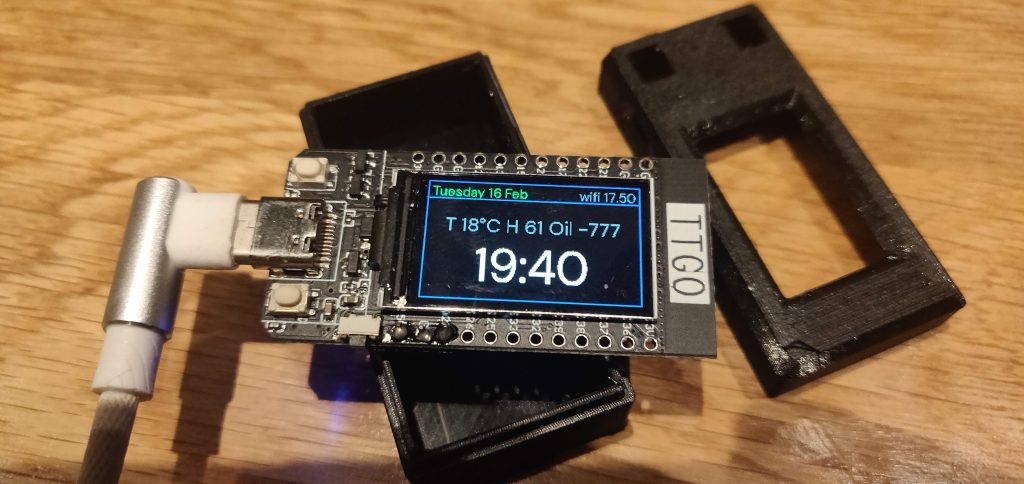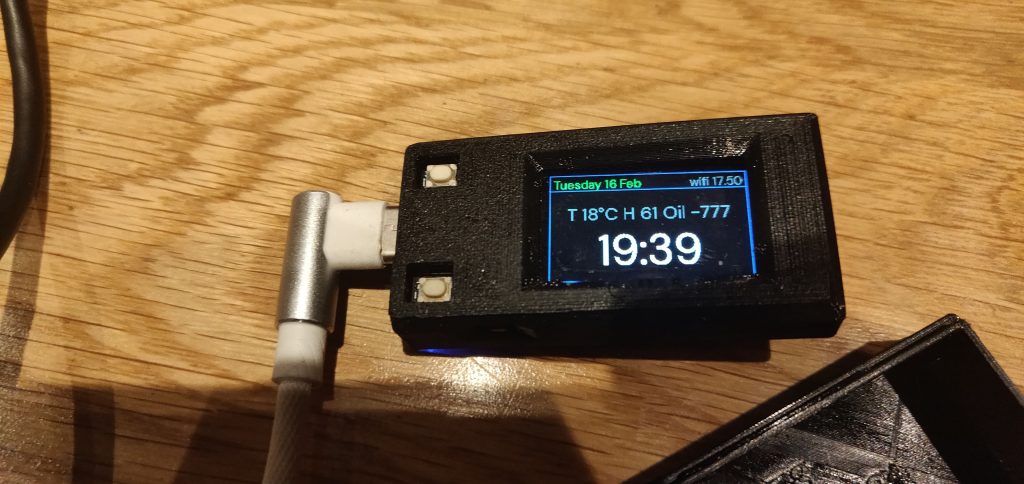see your sensor readings on a TTGO T-display ST7789V TFT LCD
If you use Home Assistant you can show temperature, time and other sensor entities on this cute display.

The inspiration for this mini-project came from a need to display my oven temperature in a convenient place in the kitchen. I might instead need to see the time of the next train, the oil tank level, my broadband speed or indeed the state of any Home Assistant sensor. This project needs only a TTGO LCD T-display and USB to power it. You’ll need a USB-C type cable because that’s what LILYGO/TTGO use on this device.
The first prerequisite for this project is a working Home Assistant setup. The last and only other need is this display and ESP32 in one unit. You can modify my code to suit your sensors.
The display is full colour, 1.14 inches and offers very good resolution. If you need to display lots of information at once consider this display project with an old monitor. I had this TTGO display for months before I knew how to work it so I hope it’s useful to bring some understanding forward. If you wanted to use a battery to power the display, a lead is supplied with the board. It helps if you’ve no sockets nearby. A phone power bank works the same more or less conveniently.

find a location for the TTGO T-display
If you use a 3D printer a search at thingiverse.com will find a suitable case to protect the unit. My kitchen location, where I glued the display to the back of a smoked glass door seemed like an ideal one. I powered the TTGO T-display via a USB splitter (1 male to 2 female). It draws very little power.

what you need for this
- a TTGO T-Display, USB cable and a USB power supply
- Home Assistant running on a Raspberry Pi – my Home Assistant setup instructions
- A Home Assistant ‘add-on’ called ESPhome which is found in the add-on store – see how I did it

go to ESPhome in Home Assistant, add a ‘new node’ and use this configuration
Go to the ESPHome section of Home Assistant and create a new device (+ sign). Follow through the ESPhome web dialogue to firstly connect to the TTGO display; prepare it and supply it with your wifi details. Next you must Adopt and rename the new device to something obvious. Ultimately you ‘edit’ the new device and add the code below to the editor panel
.
- Customize the code below using the Esphome editor and changing the options to suit.
- Put a font called Helvetica.ttf in the ESPHome folder in Home Assistant (use the File Editor to upload this). You can use any TTF font (such as Gillsans.ttf) but you must either rename it (to Helvetica.ttf) or edit the code below to get the font name right
- If nothing happens click View the logs. After pressing a (edge) button you might see ‘waiting for download’ which suggests now is the time to click Flash or Upload firmware.
# Create a new device in ESPHome. Add these lines to the device code substitutions: devicename: ttgo_oven # just change the device name above not the devicename below esphome: name: ttgo_oven platform: ESP32 board: featheresp32 logger: api: ota: captive_portal: wifi: ssid: "YOUR WIFI" password: "PASSWORD" manual_ip: # Set this to the IP of the ESP static_ip: 192.168.1.XX # Set this to the IP address of the router. Often ends with .1 gateway: 192.168.1.1 subnet: 255.255.255.0 ssid: "ttgo fallback hotspot" password: "password" # fallback hotspot (captive portal) in case wifi fails color: - id: my_red red: 100% green: 0% blue: 0% - id: my_yellow red: 100% green: 100% blue: 0% - id: my_green red: 0% green: 100% blue: 0% - id: my_blue red: 0% green: 0% blue: 100% - id: my_gray red: 50% green: 50% blue: 50% font: - file: "Helvetica.ttf" id: helvetica_48 size: 48 - file: "Helvetica.ttf" id: helvetica_24 size: 24 - file: "Helvetica.ttf" id: helvetica_S size: 14 # put a ttf font called Helvetica.ttf in the esphome folder binary_sensor: - platform: gpio pin: number: GPIO0 inverted: true name: ${devicename}top push id: tdisplay_button_input_0 - platform: gpio pin: number: GPIO35 inverted: true id: tdisplay_button_input_1 name: ${devicename}bottom push switch: - platform: restart name: ${devicename} restart # replace my entity IDs with your entity IDs below sensor: - platform: homeassistant id: oven1_temperature entity_id: sensor.oven_temperature internal: true - platform: homeassistant id: oven2_temperature entity_id: sensor.oven2_temperature internal: true - platform: homeassistant id: my_timer entity_id: timer.oventime internal: true - platform: wifi_signal name: "ttgo wifi signal" update_interval: 60s time: - platform: homeassistant id: esptime spi: clk_pin: GPIO18 mosi_pin: GPIO19 display: - platform: st7789v backlight_pin: GPIO4 cs_pin: GPIO5 dc_pin: GPIO16 reset_pin: GPIO23 rotation: 0 lambda: |- it.printf(50, 30, id(helvetica_48), id(my_yellow), TextAlign::TOP_CENTER, "%.0f°", id(oven1_temperature).state); it.printf(50, 120, id(helvetica_48), id(my_yellow), TextAlign::TOP_CENTER, "%.0f°", id(oven2_temperature).state); it.strftime(60, 0, id(helvetica_S), id(my_green), TextAlign::TOP_CENTER, "%H:%M", id(esptime).now()); it.strftime(60, 190, id(helvetica_S), id(my_green), TextAlign::TOP_CENTER, "%A", id(esptime).now());
how to configure the ESPhome code
- All of the above was adapted from the ESPhome guide to the ST7789V
- Notice that you have options to infinitely change the colour, the font and the font size.
- There are two buttons on the display and Home Assistant watches them for a press. You can use them to trigger turning on a light or relay entity found in your Home Assistant..
- The sensor section shows that you can pull information about any sensor in Home Assistant. I used oven temperatures.
- With ‘rotation’ set to O, the display is landscape, 240 pixels long x 140 pixels high. See the example at ESPHome for a portrait version of the display.
- The lamda section does the work of positioning the sensor values and the time. Yes, it’s evil – I suggest you get yourself some graph paper and experiment with the text placement.
go to Home Assistant > Integrations to add your TTGO display device entities
- Go to Home Assistant Configuration. Choose Integrations. If the display hasn’t already been discovered automatically, add ESPhome and enter the IP address you put in the code above.
the oven temperature mini- TFT screen near my cooker
A TTGO OLED T-display to display the temperature readings:


Another version of the display with code to use as needed
The display above is a later version after much fiddling with font positioning. The font used is Google’s DM Sans. I downloaded this from Google fonts, renamed “DM Sans.ttf” to “Helvetica.ttf” and put this font file in Home Assistant’s ESPhome folder.
# CHANGE THE ITEMS IN BOLD TO SUIT
substitutions:
devicename: ttgo_oven
esphome:
name: ttgo_oven
platform: ESP32
board: featheresp32
# Enable logging
logger:
# Enable Home Assistant API
api:
ota:
captive_portal:
wifi:
ssid: "YOUR WIFI"
password: "password"
manual_ip:
# Set this to the IP of the ESP
static_ip: 192.168.1.x
# Set this to the IP address of the router. Often ends with .1
gateway: 192.168.1.x
# The subnet of the network. 255.255.255.0 works for most home networks.
subnet: 255.255.255.0
# fast_connect: on
ap:
ssid: "ttgo fallback hotspot"
password: "password"
# Enable fallback hotspot (captive portal) in case wifi connection fails
color:
- id: my_red
red: 100%
green: 0%
blue: 0%
- id: my_yellow
red: 100%
green: 100%
blue: 0%
- id: my_green
red: 0%
green: 100%
blue: 0%
- id: my_blue
red: 20%
green: 20%
blue: 100%
- id: my_gray
red: 50%
green: 50%
blue: 50%
- id: my_white
red: 100%
green: 100%
blue: 100%
# put any ttf font renamed Helvetica.ttf in the esphome folder.
font:
- file: "DMSans-Bold.ttf"
id: helvetica_L
size: 76
- file: "DMSans-Bold.ttf"
id: helvetica_M
size: 34
- file: "DMSans-Bold.ttf"
id: helvetica_S
size: 24
binary_sensor:
# - platform: status
# name: "ttgo status"
# id: system_status
- platform: gpio
pin:
number: GPIO0
inverted: true
name: "ttgo_oven toppush"
id: tdisplay_button_input_0
# - platform: gpio
# pin:
# number: GPIO35
# inverted: true
# name: "ttgo_oven botpush"
# id: tdisplay_button_input_1
# name: ${devicename} rcwl27
## - platform: gpio
# pin: GPIO27
# device_class: motion
# We can still control the backlight independently
switch:
# - platform: gpio
# pin: GPIO4
# name: "ttgo_oven backlight"
# id: backlight
- platform: restart
name: ${devicename} restart
sensor:
- platform: homeassistant
id: oven1_temperature
entity_id: sensor.oven_temperature
internal: true
- platform: homeassistant
id: oven2_temperature
entity_id: sensor.oven2_temperature
internal: true
- platform: homeassistant
id: my_timer
entity_id: timer.oventime
# filters:
# - filter_out: nan
internal: true
- platform: wifi_signal
name: "ttgo wifi signal"
update_interval: 60s
time:
- platform: homeassistant
id: esptime
spi:
clk_pin: GPIO18
mosi_pin: GPIO19
# THE FOLLOWING can be uncommented to DISPLAY AN IMAGE IN THE ESPHOME FOLDER
#image:
# - file: "image.png"
# id: my_image
# resize: 200x200
# type: RGB24
display:
- platform: st7789v
backlight_pin: GPIO4
cs_pin: GPIO5
dc_pin: GPIO16
reset_pin: GPIO23
rotation: 270
lambda: |-
it.printf(80, 45, id(helvetica_L), id(my_yellow), TextAlign::TOP_CENTER, "%.0f°", id(oven1_temperature).state);
it.printf(185, 70, id(helvetica_M), id(my_yellow), TextAlign::TOP_CENTER, "%.0f°", id(oven2_temperature).state);
it.strftime(40, 0, id(helvetica_S), id(my_white), TextAlign::TOP_CENTER, "%H:%M", id(esptime).now());
it.strftime(165, 0, id(helvetica_S), id(my_white), TextAlign::TOP_CENTER, "%A", id(esptime).now());
Excellent tutorial, and working flawless. Simetimes i lose wifi cionbnection, si i woukld like to show th ip adress of the TTGO. Found out that you should use text sensor for wifi but i can;t get it to work. Any suggestions.
Cheers Erik. Knowing the ip address might be useful. Displaying the wifi signal strength might be useful too.
The text sensor instructions could be more helpful and provide examples. My suggestion is to send the IP address to HA and then use ‘- platform: homeassistant’ to get it back and to display it in the lamdba line with other variables. If that’s not clear shout back.
text_sensor:
– platform: wifi_info
ip_address:
name: ESPIPAddress
AND THEN
sensor:
– platform: homeassistant
id: ipaddress
entity_id: sensor.ESPIPAddress
internal: true